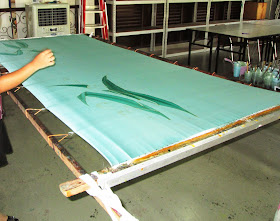Malaysia- Batik 2
Batik
is a method of design using wax resist. The origins of this design technique
remain unclear. We know this process dates back to Egyptian times, nearly 2,000
years ago, from samples found in Egyptian tombs. Some believe SE Asian batiks originated in India as India
produced the fine cotton necessary for the fine detailing of the designs.
The
word “batik” comes from Malay “tik” meaning spot,dot or drop. There are over 3,000 batik designs, which
are grouped as follows:
- geometric: garis
miring, ceplokan, kawang, tumpal, and tambal miring (a kind of patchwork
design believed to have magical properties.)
- non-geometric: semen
(swirling foliage with stylized animals and birds, cloud designs)
- isen : simple,
repetitive background designs found
in the less expensive batiks
Motifs
were inspired by culture, religion and nature.
There are few contemporary batik motifs, instead the tradition continues
with the continued use of traditional designs.
One
method of applying the resist is the use of a “canting”(Tjanting), a small
copper vessel with a spout, resembling the bowl of a pipe with an attached
handle. Cantings may have more than one
spout in parallel. The bowl is filled
with the molten wax (made from beeswax and paraffin) and holding the tool like
a stylus the artist draws the design with the wax flowing from the spout. This type of batik is referred to as Tulis, meaning to write or draw. Since
true batik is reversible, the waxing process must be repeated on the reverse
side. The artist draws freehand and, therefore, Tulis batik may be very
intricate.

Because
producing designs with a canting is very time-consuming, batik artists may use
a metal block made of strips of thin copper set upright soldered to a metal
base with a curved metal handle. Using this metal tool (called a “cap”) dipped
into molten wax, a single worker could stamp up to 20 lengths of cloth per day
as each cap consists of the entire design element. Several caps of different sizes and shapes could be used, with as
many as ten pairs of caps needed for complex designs
After
the waxing, the first dying is done using a combination of chemical and natural
dyes. After the initial dying, wax from
the areas next to be dyed is scraped away or reapplied for additional
dyeing. Once all color has been applied
the fabric is washed and soaked in as fixing solution. Thorough rinsing follows and a boiling water
bath melts remaining wax, which is then saved.







No comments:
Post a Comment